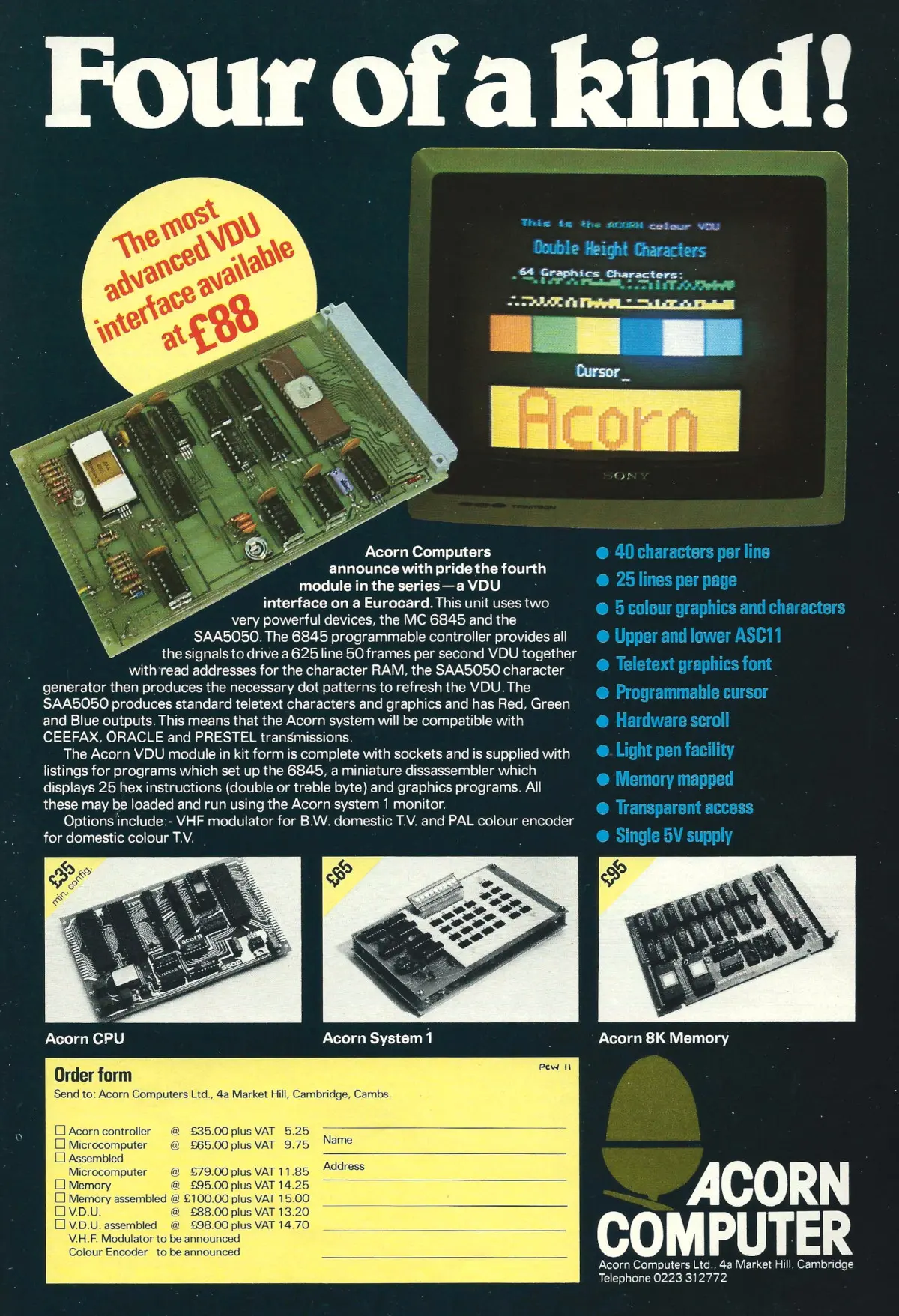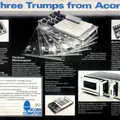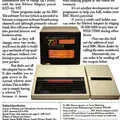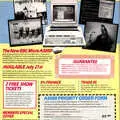
Acorn Advert - September 1979
From Personal Computer World

Three Trumps from Acorn: The Acorn Microcomputer
Acorn was founded as Cambridge Processor Unit (CPU) in November 1978 by Hermann Hauser, who had moved to the UK from Vienna at the age of 15[1], and Chris Curry - a former Science of Cambridge, a.k.a. Sinclair (and before that Sinclair Radionics) employee.
Curry, armed with one A-Level, had done stints as a student apprentice with Pye in Cambridge, and as a scientific assistant at the Ministry of Defence before starting with Radionics in 1966 as a development engineer. Whilst there, as well as working on hi-fi, he designed the famous Sinclair Executive calculator in 1971.
In 1976, as Radionics was being part-nationalised by the National Enterprise Board, Curry left under Clive Sinclair's direction to wake up a dormant shell company - Ablesdeal - which Sinclair had originally purchased in 1973.
By the time Curry became involved with Sinclair's moonlighting operation, it had already been renamed Westminster Mail Order and by then was known as Sinclair Instruments[2]. It would eventuall become Science of Cambridge.
SoC went on to develop and launch the MK-14 microprocessor kit, which proved popular with a raft of previously undiscovered enthusiasts.
To help with the unexpected level of support, Curry hired his friend and PhD student Hauser out of Cambridge University, where the latter had studied physics at the prestigious Cavendish Physics Laboratory - the pair meeting whilst Hauser was doing post-doctorate studies.
Coming out of Curry's interest in home computers and Hauser's research in to the needs of home computer users, the pair left Science of Cambridge at the end of 1978 to start CPU, from which Acorn was born[3].
Perhaps not unexpectedly, the company's first product was a kit-form micro not unlike the MK-14 called the Acorn Microcomputer.

An apparently photo-shy and stern-looking Chris Curry, © Personal Computer News, Jan 7th 1984The Acorn Microcomputer, known later on as the Acorn Microcomputer System 1 or just Acorn System 1[4] was launched in March 1979.
It was fundamentally an "Acorn Controller" - a board intended as an industrial control module, with its 32 lines of Input/Output - mounted on a Eurocard-format board with a keyboard, 8 digit 7-segment LED display and a tape interface for storage.
It was also similar in concept to 1975's Mos KIM-1, not least as both shared the same 1975-designed 6502 CPU, although it benefitted from the four years since the KIM-1 was released by having a much lower chip count.
The kit was designed to be both ahead of the competition, as well as easy to use - although that was relative to other comparable boards at the time, given that it still used hexadecimal input via a hexadecimal keyboard.
Hauser recounted one of its early public appearances in an interview with Personal Computer World in May 1993, saying:
"I'll never forget this exhibition we went to. We showed this thing assembled and it was all working. It was beautiful: it had an LED seven-segment display. It was all dots when it was in the reset state so you knew everything was working, which wasn't very often - but remember in those days people really preferred those computers not to work because it gave them a chance to fix them".
Part of the kit's eventual success was said to be down to Sophie Wilson - then an undergraduate at Cambridge University - who apparently showed up one day and said she could build a computer kit that was better than those on the market at the time.
Wilson was challenged to produce a prototype and within a week had returned with a hand-wired board, along with some systems software.
The software had to be written to programmable read-only memory, but needed testing first, with Hauser recounting:
"'This is all very well, but how are you going to debug it?' It was very difficult to debug things, and we didn't have a debugger because we were poor in those days. And [Wilson] said: 'Oh, it doesn't need debugging, I've written it to be correct'".
The software was written to PROM and worked first time, with only two small flaws which the software itself was used to find. The second version contained the fixes, and was the one shipped to customers[5].
The Acorn Microcomputer was available both in kit form for £74.75 - about £530 in 2026 money - or £86.25 (£610 in 2026) pre-built.
It shipped with only 1.25K memory, but an 8K module was available for £109.25, or £780 in 2026 - about 40% more than the entire kit computer cost.

An advert which appeared in Personal Computer World two months later, which shows one of the Eurocard modules available for Acorn's Microcomputer - a colour Video Display Unit interface. It retailed for £88 (about £630 in 2026), which was also more than computer it attached to
Acorn's revenue for the whole of 1979 was £31,000[6], but by the end of 1984, Curry - head of a company thought to be worth around £100 million - was on a salary of £60,000 (£240,000 in 2026) and was living in a 15-bedroom mansion, which Curry described as "a totally unneccesary extravagance".
He attributed his fame and fortune to long morning bathtime sessions, where we would often have his best ideas but which would often make him late for work.
It was also revealed that Curry was "pretty hopeless" with computers. He said:
"I've got a computer at home. I play games on it, I'm afraid, and rather badly too. Someone told Clive Sinclair once that I was starting to make quite a lot of money, and he said 'Chris Curry? Oh, he's always behaved like a rich man'"[7].
Date created: 01 July 2013
Last updated: 23 December 2025
Hint: use left and right cursor keys to navigate between adverts.
Sources
Text and otherwise-uncredited photos © nosher.net 2026. Dollar/GBP conversions, where used, assume $1.50 to £1. "Now" prices are calculated dynamically using average RPI per year.

























